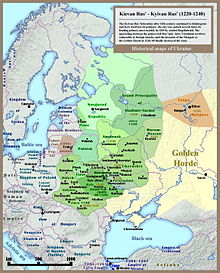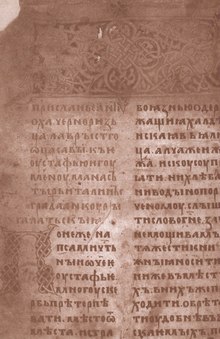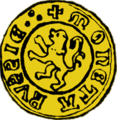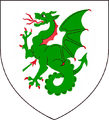Kingdom of Galicia–Volhynia
Principality of Galicia–Volhynia (1199–1253) Kingdom of Ruthenia (1253–1349/1392) | |||||||||||||
|---|---|---|---|---|---|---|---|---|---|---|---|---|---|
| 1199–1349/1392 | |||||||||||||
 Map of the Kingdom of Galicia–Volhynia in the 13th/14th century. | |||||||||||||
| Status | Principality (until 1253) Kingdom (after 1253) Vassal state of the Golden Horde (from 1246) | ||||||||||||
| Capital | |||||||||||||
| Common languages | Lubart | ||||||||||||
• 1383–1392 | Theodore of Volhyniapl | ||||||||||||
| Historical era | Middle Ages | ||||||||||||
• Principality | 1199 | ||||||||||||
• Kingdom | 1253 | ||||||||||||
• Loss of Halych to Poland | 1349 | ||||||||||||
• Volhynia falls to Lithuania | 1392 | ||||||||||||
| |||||||||||||
The Principality or, from 1253, Kingdom of Galicia–Volhynia
Geographically, western Galicia–Volhynia extended between the rivers
History
Tribal period
After the fall of the Roman Empire, the area was populated by
In the 12th century, the Principality of Halych was formed there by descendants of Vladimir the Great. It merged at the end of the 12th century with the neighboring Principality of Volhynia into the principality of Galicia–Volhynia, which existed with some breaks for a century and a half.[citation needed]
Reign of Roman the Great (1199–1205)
In Roman's time Galicia–Volhynia's principal cities were
War of succession (1205–1245)

In 1205, Roman's alliance with the Poles broke down,
After Roman's death, the Galician boyars first drove Roman's widow
In 1221, Mstyslav Mstyslavich the Able, son of Mstislav Rostislavich (descendant of the princes of Novgorod), liberated Galicia–Volhynia from the Hungarians and Poles.[10] During Mstyslav's 1221–1228 reign, the Galician and Volhynian armies participated in the Battle of the Kalka River (1223) against the Mongols, but in 1228 the boyars expelled him and transferred the Principality of Galicia to the king of Hungary.[10] It was Danylo Romanovych (also known as Daniel of Galicia, or Danylo Halytskyi), son of Roman, who formed a real union of Volhynia and Galicia.[citation needed] Danylo first established himself in Volhynia.[10] After failing to retake his father's other throne in 1230–1232 and 1233–1235, Danylo succeeded upon his third attempt and conquered Halych in 1238, reunited Galician and Volhynia, and ruled for a quarter century.[12] In March 1238, he defeated the Teutonic Knights of the Order of Dobrzyń in the Battle of Dorohychyn.[10][a] Danylo captured Kyiv in 1239,[13] just before the Mongols besieged, conquered and sacked the city in late 1240.[12] On 17 August 1245, Danylo and his brother Vasylko defeated the Polish and Hungarian forces (weakened by the first Mongol invasion of Poland and the first Mongol invasion of Hungary in early 1241[12]) in the Battle of Yaroslav (Jarosław), taking full control of Galicia–Volhynia.[10] The brothers also crushed their ally Rostislav Mikhailovich, son of the prince of Chernihiv.[citation needed]
Reign of Danylo (1245–1264)

Danylo strengthened his relations with
In 1245,
Under Danylo's reign, the Kingdom of Ruthenia was one of the most powerful states in east central Europe,]
Reign of Lev (1264–1301)
After Danylo's death in 1264, he was succeeded by his son
Decline (1301–1340)

After Lev's death in 1301, a period of decline ensued. Lev was succeeded by his son
After the extinction of the Rurikid dynasty in Kingdom of Rus in 1323, Volhynia passed into the control of the Lithuanian prince
Final years and aftermath (1340–1392)



From 1340 to 1392, the civil war in the region transitioned into a power struggle between Lithuania, Poland, and Hungary. The first stage of conflict led to the signing of a treaty in 1344 that secured the
Following the death of
Historical role
The Galician-Volhynian Chronicle reflected the political programme of the Romanovich dynasty ruling Galicia–Volhynia. Galicia–Volhynia competed with other successor states of Kievan Rus' (notably Vladimir-Suzdal) to claim the Kievan inheritance. According to the Galician–Volhynian Chronicle, Kingdom of Rus King Daniel was the last ruler of Kiev preceding the Mongolian invasion and thus Galicia–Volhynia's rulers were the only legitimate successors to the Kievan throne.[21] Until the end of Galician-Volhynian state, its rulers advanced claims upon "all the land of Rus'." The seal of King Yuri I contained the Latin inscription domini georgi regis rusie.[21]
In contrast to their consistent secular or political claims to the Kievan inheritance, Galicia's rulers were not concerned by religious succession. This differentiated them from their rivals in Vladimir-Suzdal, who sought to, and attained, control over the Kievan Church. Rather than contest Vladimir-Suzdal's dominance of the Kievan Church, Kingdom of Rus' rulers merely asked for and obtained a separate Church from Byzantium.[21]
Galicia–Volhynia also differed from the northern and eastern principalities of the former Kievan Rus' in terms of its relationship with its western neighbors. King Danylo was alternatively an ally or a rival with neighboring Slavic Poland and partially Slavic Hungary. According to historian
In Ukrainian historiography, the Kingdom of Galicia-Volhynia played an important role, uniting the western and southern branches of East Slavs and consolidating their identity, and becoming a new center of political and economic life after the decline of Kiev.
Administrative structure




The principality was divided into several appanage duchies and lands:
- Principality of Halych
- Principality of Volhynia
- Principality of Belz
- Land of Chełm(Lublin 1289–1302)
- Land of Berestia
- Black Ruthenia, a fief of Grand Duchy of Lithuania after a treaty between Daniel of Galicia and Vaišvilkas
Temporary divisions
- Principality of Kiev (1230–1240)
- Principality of Turow (1230s)
- Zakarpattia (1280–1320) ???
Rulers
| History of Ukraine |
|---|
 |
|
|
This section needs additional citations for verification. (January 2023) |
- 1199–1205 Roman the Great (in Volhynia since 1197, in Galicia since 1199)[8]
- 1205–1214 political crisis
- 1205–1206 Euphrosine Angelina (daughter of Isaac II Angelos) as a regent for Danylo/Daniel of Galicia
- 1206–1212: the three sons of Ihor Svyatoslavych: Volodymyr Ihorevych, Svyatoslav Ihorevych, and Roman Ihorevych.[10]
- 1210 Rostislav II of Kiev (short stint)
- 1211–1212 Mstislav the Mute as a regent for Danylo/Daniel of Galicia
- 1212–1214 Uprising led by a boyar Volodyslav Kormylchych
- 1214–1232 Hungarian occupation, sons of Andrew II of Hungary
- 1214–1220 Coloman, son of Andrew (King of Galicia and Lodomeria)
- 1220–1221 Uprising led by Mstyslav the Able, who ruled in Halych from 1221 to 1228[10]
- 1220–1232 Andrew, son of Andrew
- 1214–1220
- 1232–1235 Danylo/Daniel of Galicia
- 1235–1238 children of Michael of Chernigov
- 1238–1264 Danylo/Daniel of Galicia[10]
- 1264–1269 Dual power descendants of Daniel
- 1301–1308 Yuri I of Galicia
- 1308–1323 Dual power descendants of Yuri
- 1308–1323 Lev II of Galicia
- 1308–1323 Andrew of Galicia
- 1308–1323
- 1323–1349 political crisis, de facto ruled by a boyar Dmytro Dedko
- 1323–1325 Galicia: Volodymyr I Lvovych of Galicia, Volhynia: Liubartas
- 1325–1340 Yuri II Boleslav(united as compromise)
- 1340 takeover of Galicia by Casimir III the Great
- 1341–1349 Liubartas
- 1349 Galicia annexed (patrimonial) by Poland and Hungary, Volhynia – Lithuania
Notes: The senior branch of Rurikid dynasty, in the 14th century Galician rulers came in close relations with Mazovian Piasts (
Gallery
-
Saint Pantaleon Church, Shevchenkove, Halych Raion, 1194
-
Map ofPokuttiain 1648 east of Ruthenia
-
"Moneta Rvssie" coined in 1382 based on groschen
-
Coins of Dux Wladislaus
See also
- Civil war in Greater Poland (1382–1385)
- List of Ukrainian rulers
- List of early East Slavic states
- List of rulers of Galicia and Volhynia
- Ruthenian nobility
- Metropolis of Halych
Notes
- ^ The Order of Dobrzyń was named after the now-Polish town of Dobrzyń nad Wisłą (Ukrainian: Добжинь-над-Віслою, romanized: Dobzhyn"-nad-Visloyu). The site of the battle was the now-Polish town of Drohiczyn (Ukrainian: Дорогичин, romanized: Dorohychyn).
References
- ISBN 9780802037817.
- ^ It is also called Galich-Volhyn, Galicia–Volynia, Galicia–Volyn, and Galich–Volyn, Halych–Volhyn, Halych–Volhynia, or Galicia–Vladimir
- ^ "Codex diplomaticus Hungariae ecclesiasticus ac civilis. Tomi IX. Vol. 4. (Budae, 1834.) | Könyvtár | Hungaricana".
- ^ a b Michael B. Zdan – The Dependence of Halych-Volyn' Rus' on the Golden Horde, The Slavonic and East European Review, Vol. 35, No. 85 (Jun., 1957), p. 522
- ^ "Oleg of Novgorod | History of Russia". historyofrussia.org. Retrieved 2016-02-14.
- ^ Ипатьевская летопись. — СПб., 1908. — Стлб. 21
- ISBN 978-0-521-03981-9.
- ^ a b c d e f g h i j k l Magocsi 2010, p. 124.
- ^ a b c d Encyclopedia of Ukraine, Roman Mstyslavych
- ^ a b c d e f g h i j k l m n o p Katchanovski et al. 2013, p. 197.
- .
- ^ a b c d e f Magocsi 2010, p. 125.
- ^ "Danylo Romanovych". encyclopediaofukraine.com. Retrieved 22 January 2023.
Danylo unified Volhynia. He failed in several attempts to gain control of the princely Halych, but finally succeeded in 1238, with the support of the burghers. The next year he took Kyiv, which had entered his sphere of influence earlier, and placed Voivode Dmytro in charge of the principality.
- ^ Vernadsky 1970, p. 144–149.
- ^ Magocsi 2010, p. 125–126.
- ^ a b c d Magocsi 2010, p. 126.
- ^ John Joseph Saunders. (2001). The history of the Mongol conquests. Philadelphia: University of Pennsylvania Press, p101
- ^ a b Vernadsky 1970, p. 157.
- ^ a b "Daniel Romanovich" Archived 2007-08-24 at the Wayback Machine. Encyclopædia Britannica. 2007. Britannica Concise Encyclopedia. 23 August 2007
- ^ Zdan, Michael B. "The Dependence of Halych-Volyn' Rus' on the Golden Horde." The Slavonic and East European Review, Vol. 35, No. 85 (June, 1957), p. 521-522
- ^ a b c Jarosław Pelenski. In P. Potichnyj (ed.) (1992). Ukraine and Russia in their historical encounter. Edmonton, Alberta: Canadian Institute of Ukrainian Studies Press, University of Alberta. pp.8–15
- ^ "Роль Галицько-Волинського князівства в історії української державності - Галицько-Волинська держава — спадкоємиця Київської Русі - Посібник О.Д. Бойко - Історія України - Статті - Шкільна програма 12 класів". uahistory.co (in Ukrainian). Retrieved 2022-08-05.
- ^ "Історія України: Галицько-Волинське князівство. Литовсько-польська доба". ВУЕ (in Ukrainian). Retrieved 2022-08-05.
Sources
- ISBN 9780810878471. Retrieved 22 January 2023.
- ISBN 9781442610217. Retrieved 21 January 2023.
- ISBN 0-8020-8390-0.
- Vernadsky, George (1970). The Mongols and Russia. A History of Russia, Volume III. New Haven: Yale University Press.
- Litopys.org.ua
- Галицько-Волинський Літопис. Іпатіївський список
- Галицько-Волинський Літопис. Іпатіївський список
- Галицько-Волинський Літопис. Острозький (Хлєбниковський) список
- Галицько-Волинський Літопис. Переклад Л.Махновця
- Литовсько-білоруські літописи
- Список городів руських дальніх і близьких
- Перелік джерел за "Крип'якевич І. Галицько-волинське князівство. Київ, 1984"
- Ілюстрації з "Chronicon Pictum"
- Болеслав-Юрий II, князь всей Малой Руси: Сборник материалов и исследований. — Санкт-Петербург, 1907.
Further reading
Cyrillic
- Андрияшев А. М. Очерки истории Волынской земли до конца XIV ст. Киев, 1887.
- Галицкий исторический сборник, 1854, вып. 2.
- Греков Б. Д. Древнейшие судьбы славянства в Прикарпатских. областях // Вестник АН СССР. 1940. No. 11–12.
- Греков Б. Д. Крестьяне на Руси. — Москва,1952.
- Иванов П. А., Исторические судьбы Волынской земли с древнейших времен до конца XIV века, Одесса, 1895.
- Крип'якевич І. Галицько-волинське князівство. Київ, 1984.
- Коваленко В. Чернігів і Галич у ХІІ — ХІІІ ст. // Галичина та Волинь у добу Середньовіччя. — Львів, 2001. — С.154–165.
- Котляр М. Ф. Данило Галицький. — Київ, 1979.
- Материалы для истории и этнографии края. — Волынския губернския ведомости, 1854.
- Пашуто В. Т., Очерки по истории Галицко-ВольІнской Руси. — Москва, 1950.
- Руссов С. Волынские записки сочинінные Степаном Руссовым в Житомире. — Санкт-Петербург, 1809.
- Шабульдо Ф. М. Земли Юго-Западной Руси в составе Великого княжества Литовского. Киев, "Наукова думка", 1987.[permanent dead link]
Latin
- Bielowski A. Halickowlodzimierskie księstwo. — Biblioteka Ossolińskich., t. 4.
- Bielowski A. Królewstwo Galicji (o starem księstwie Halickiem). — Biblioteka Ossolińskich, 1860, t. 1
- Gebhard L. A. Geschichte des Konigreiches Galizien, Lodomerien und Rotreussen. — Pest, 1778;
- Engel J. Ch. Geschichte von Halitsch und Vlodimir. — Wien, 1792.
- Harasiewicz M. Berichtigung der Umrisse zu einer Geschichte der Ruthenen. — Wien, 1835.
- Harasiewicz M. Annales ecclesiae Ruthenae. — Leopoli, 1862.
- Hoppe L A. Geschichte des Konigreiches Galizien und Lodomerien. — Wien, 1792.
- Lewicki A. Ruthenische Teilfürstentümer. — In: Österreichische Monarchie im Wort und Bild Galizien. Wien, 1894.
- Siarczyński F. Dzieje księstwa niegdyś Przemyślskiego. — Czasopism naukowy Biblioteki im. Ossolińskich, 1828, N 2/3;
- Siarczyński F. Dzieje niegdyś księstwa Belzkiego i miasta Belza. — Czasopism naukowy Biblioteki im. Ossolińskich, 1829, N 2.
- Stecki J. T. Wołyń pod względem statystycznym, historycznym i archeologicznym. — Lwów, 1864
- Zubrzycki D. Rys do historii narodu ruskiego w Galicji i hierarchii cerkiewnej w temże królewstwie. — Lwów, 1837.
- Zubrzycki D. Kronika miasta Lwowa. — Lwów, 1844.
External links
- Довідник з історії України. За ред. І. Підкови та Р. Шуста. — Київ: Генеза, 1993. Archived 2009-04-10 at the Wayback Machine
- Галицько-волинські князі
- Ісаєвич Я. Князь і король Данило та його спадкоємці // Дзеркало тижня. 2001, №48 (372)
- Карта Галицько-Волинського князівства
- Володимир-Волинський у «Галереї мистецтв»
- Борис Яценко, «Слово о полку Ігоревім» та його доба («Slovo o polku Ihorevim» ta joho doba)
- Волинська земля у складі Галицько-Волинського князівства (Volynśka zemľa u skladi Halyćko-Volynśkoho kńazivstva)
- За що боролись (Za ščo borolyś) Archived 2009-07-11 at the Wayback Machine










